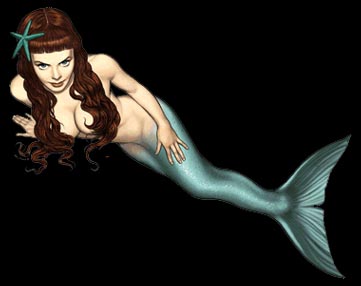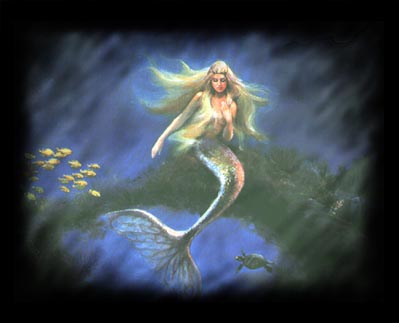Mermaid
Generally called Merfolk, Mermaids are mythical creatures with the tail of a fish and the head, arms and trunk of a woman. Its male counterpart is called a Merman.
"From the navel upward, her back and breasts were like a woman's... her body as big as one of us; her skin very white; and long hair hanging down behind, of color black; in her going down they saw her tail, which was like the tail of a porpoise, and speckled like a mackerel."
This remarkable account of the sighting of a mermaid is taken from the journal of the English navigator Henry Hudson. He was describing what two of his crew claimed to have seen on June 15, 1608, when looking overboard from Hudson's ship off the coast of Novaya Zemlya, a group of islands off northern Russia.
The origins of a half-human, half-fish creature date back to earliest history. The Babylonian god of the waters called Oannes was often portrayed as a man with a fish's tail, and a Syrian moon deity known as Atargatis, filled with shame after bearing a daughter by a young man, cast herself into a lake, whereupon her lower half turned into a fish's tail. Images of mermaids, and myths about them, abound in the art and literature of the world (there are carvings of them in many medieval cathedrals) — but of particular interest are the various encounters with these creatures that have been reported throughout history.
In 1403, for example, at Edam, in Holland, some women and their servants claimed to have found a mermaid stranded in floodwater from the sea. Describing this event in his Speculum Mundi (1635), English minister John Swan wrote:
"She suffered herself to be clothed and fed...she learned to spin and perform other petty offices of women...she would kneel down with her [mistress] before the crucifix, she never spake, but lived dumb and continued alive (as some say) fifteen years."
On January 4, 1493, Christopher Columbus, nearing the end of his first voyage of discovery in the Americas, entered in his journal that, off the coast of Haiti, he and his crew had seen three mermaids rise high from the sea:
"They were not as beautiful as they are painted, although to some extent they have a human appearance in the face...."
Columbus also noted that he had seen similar creatures on an earlier voyage, off the coast of Guinea, West Africa.
Among the considerable catalog of more modern alleged sightings, one of the most remarkable is that which took place in about 1830 on the island of Benbecula off northwest Scotland. The account claimed that a woman washing her feet in the sea saw a mermaid, that the creature escaped (but not before being hit in the back by a stone), and that a few days later its dead body was washed up on the shore.The British folklorist Alexander Carmichael heard this story, he reported, from "persons still living who saw and touched this curious creature." In Carmina Gadelica (1900) he wrote:
"The upper part of the creature was about the size of a well-fed child of three or four...with an abnormally developed breast. The hair was long, dark and glossy, while the skin was white, soft, and tender. The lower part of the body was like a salmon, but without scales."
The sheriff of the island was said to have had a coffin made for the mermaid, which was buried on the shore.
The mermaid caught in Belfast Lough in Northern Ireland in AD 558 had an unusual past. Three hundred years earlier she had been a little girl named Liban, whose family died in a flood. She lived for a year beneath the waves, gradually being transformed into a mermaid. The mermaid eventually gave herself away by singing beneath the waves. She was overheard, and a party of men rowed into the lake and caught her in a net. They called her Murgen, which means "sea born," and displayed her in a tank of water for everyone to see. She was baptized, and when she died, she was called St. Murgen. Many miracles were attributed to her.
In I403 another mermaid was stranded on mud flats in the Netherlands. According to a 17th century historian, she was befriended by village women who "cleansed her of the seamosse, which did stick about her." She never learned to speak but lived for 15 years and was given a Christian burial in the local churchyard.
The beautiful mermaid of the Holy Island of Iona (off Scotland) daily visited an unknown saint who lived there. She was in love with him and wanted the soul that mermaids lack. The saint told her that to gain a soul she must renounce the sea. This was impossible, so she left in despair and never returned. But her tears remained and formed the gray-green pebbles that are found only on the island.
Mermaids appear in the oldest legends of some of the world's most ancient cultures. The Philistines and the Babylonians of Biblical times worshipped fishtailed gods. Mermaids appear on Phoenician and Corinthian coins. Alexander the Great, it was said, had several adventures with beautiful sea maidens, visiting the bottom of the sea in a glass globe. The Roman writer Pliny recounts how an officer of Augusts Caesar saw many mermaids "cast upon the surds and lying dead" on a beach in faraway Gaul.
In folk tradition mermaid stories are often pathetic. The mermaids are lonely, occasionally taking human form for a night to join in village fun. Sometimes a man will seize their magic cap or belt, preventing their return to the sea, often with disastrous consequences. Marriages with humans are seldom happy, although some coastal people, notably in northwestern Scotland and southeastern England, claimed they had mermaids for ancestors.
| | | | | |  | | | | | |
In the Middle Ages distinguished French families tampered with their pedigrees to claim ancestry from the mermaid Melusine, wife of Raymonde, a relative of the Count of Poitiers. Their love story had a typically tragic ending. A condition of the marriage was that Raymonde should leave Melusine alone on Saturdays. For years they lived happily together. But one Saturday, egged on by family gossip, he peeped at his wife through the bathroom key-hole. She was sitting in the bath, partially transformed, with a fish's tail. Melusine cried out in dismay and fled through the window. Raymonde never saw her again, though she would return at night to suckle her babies. Nurses saw a gleaming figure with a blue and white scaly tail hovering over the cradles.
Sailors returning from far-off lands and seas often told of seeing mermaids and "sea wives." A detailed description of a "see wyf" found in the East Indies appears in a lavishly illustrated work on marine life in the Indian seas, published in Amsterdam in 1718. It reads:
"Zee wyf. A monster resembling a siren, caught near the island of Borneo in the Department of Amboina. It was 59 inches long and in proportion as an eel. It lived on land, in a vat full of water, during four days seven hours. From time to time, it uttered little cries like those of a mouse. It would not eat, though it was offered small fish, shells, crabs, lobsters, etc."
An African who posed as a mermaid had a more serious purpose — to save his life. King Chen, a 14th century ruler of Benin (now part of Nigeria), became paralyzed in his legs — and tribal custom demanded that Kings who grew old and sickly should be put to death. But the wily King Chen claimed he was the reincarnation of a sea god and had legs like a mud fish. This gave him an excuse not to walk and to hide his legs from his subjects' view. There is a statue of him in this form in the British Museum.
| | 
| | | | | |
Perhaps no one found the mermaid myth more profitable than the enterprising London taxidermist who in the 1830's manufactured a hideous creature he said was half-fish, halfhuman. It was displayed in a London hall and sold to two Italian brothers for about $50,000. A naturalist of the time complained that the creature was a monkey stitched onto the skin of a fish. This monkey and fish combination was also the basis of a flourishing trade in mermaids by which 19th century Japanese fishermen supplemented their incomes. Many specimens found their way to Europe to be exhibited in traveling circuses and fairs.
The mermaid legend almost certainly goes back to the fishtailed gods of early civilizations. But probably it owes most to those creatures of the sea that seem almost human. In tropical waters sea mammals, such as the dugong and the manatee, rise up in the water as they suckle their young perhaps this is the origin of a constant theme of the mermaid nursing her child. In colder regions there are the seals that love to bask on the rocks uttering strange cries. Credulity, wishful thinking, mistaken identity whatever the origins, the mermaid myth dies hard. In 1961 the Manx (Isle of Man) Tourist Board offered a prize to anyone who could bring in a mermaid from the sea alive, of course.
See Troy, Zeus, Apollo, Delphi, Olympians, Greeks, Hermes, Hera, Hades, Bacchus, Centaurs, Cerberus, Daedalus, Dionysus, Mars, Vulcan, Oracle, Olympus, Tarpeian Rock, Tartarus, Telegonus, Telemachus, Mystic Gifts and Charms - New Age Gift Shop & Wicca and Pagan Supplies, Love Spells -- Use these powerful love spells to help you find and keep your true love, The Chakra Store, The Tarot Store, Divination & Scrying Tools and Supplies, Unique Amulets, Talismans, Good Luck Charms, and Love Tokens, Powerful Witch Doctor Spell Kits, Powerful Spells - Cast by Andreika the Witch, Webmasters Make $$$, AzureGreen - Celebrating All Paths to the Divine, ISIS - Tools for Your Soul's Journey, and The Pyramid Collection - Myth, Magick, Fantasy and Romance..
Sources: (1) Cooper, J.C. (Editor), Brewer's Book of Myth and Legend, Cassell Academic Publishing; (2) Evans, Bergen, Dictionary of Mythology, Dell Publishing Co., Inc.; (3) Dixon-Kennedy, Mike, Encyclopedia of Greco-Roman Mythology, ABC-Clio Inc. Publishers.
| | |